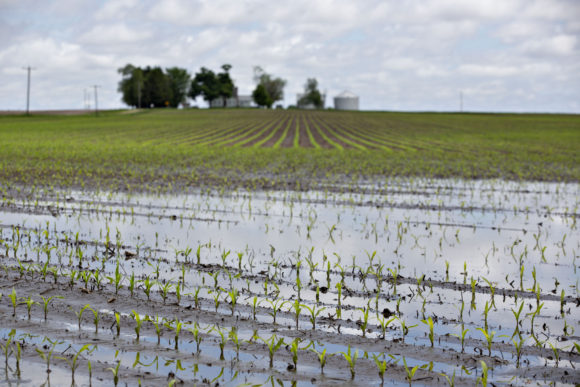Downpours that have hampered crop planting and boosted grain prices could prove a hurdle for Sanderson Farms Inc., as the U.S.’s third-largest chicken producer is yet to cover some grain costs.
The company has locked in all its corn needs through July, and 40% of its demand for August and September, according to Chief Executive Officer Joe Sanderson. Soybean meal purchases through September are also covered. That still leaves grain to be priced for a part of the fiscal year that ends Oct. 31.
It’s the latest evidence of the far-reaching impact of the wet weather that’s fueled speculation farmers won’t be able to get corn seeds in the ground. Futures of the grain have surged more than 20% to a three-year high over the past few weeks and the chaos is expected to leave a record number of corn acres unplanted this year.
While the company’s feed cost per pound of chicken has already risen 3% in the second quarter, Sanderson expects overall feed expenses to be lower this year. If the company hedged all its grain needs at Wednesday’s price, the cost would still be $31.4 million lower than a year earlier.
Grain prices would have to “move up really significantly for us to pay more this year than last year because we have a $31 million cushion,” Chief Financial Officer Mike Cockrell said by phone after reporting second-quarter earnings. “It’s theoretically certainly possible that in the next call we say our costs are going to go up, but that would be a significant move.”
The company had opportunities to lock in its grain costs when prices fell following bearish reports from the U.S. Department of Agriculture in April and May, Sanderson said. A drop in prices following the breakdown of trade talks between China and the U.S. in mid-May was also a chance to buy.
Buying Opportunity
“We thought we should book some grain through the summer and through our fiscal year, so we did, and we had those opportunities to book it at what looks now pretty good prices,” Sanderson said, adding that the company already had some visibility on the slow pace of plantings at the time. “We won’t know until September of October if that was wise or not.”
Concerns about higher feed costs prompted an industry-wide sell-off Wednesday, when Sanderson Farms declined 4.5%. Shares rebounded Thursday after the company’s earnings beat analyst estimates.
The unfavorable weather in the U.S. has Rabobank predicting an unprecedented number of unplanted acres of corn this year, and a Bloomberg survey of 10 traders and analysts indicates growers could file insurance claims for about 6 million corn acres they haven’t been able to sow, almost double the record in 2013.
“It’s an unusual wet year, but we are comfortable with where we are right now,” Sanderson said.
Was this article valuable?
Here are more articles you may enjoy.


 Uber Sued by FTC Over ‘Deceptive’ Subscription Sign-Ups
Uber Sued by FTC Over ‘Deceptive’ Subscription Sign-Ups  Uber Spends Six Figures on Ads in Latest NY Insurance Reform Push
Uber Spends Six Figures on Ads in Latest NY Insurance Reform Push  Report: Insurers Pay $1.6B in Dog Bite Claims, as Frequency Soars
Report: Insurers Pay $1.6B in Dog Bite Claims, as Frequency Soars  Auto Lobbying Groups Unite to Pressure Trump for Tariff Relief
Auto Lobbying Groups Unite to Pressure Trump for Tariff Relief 